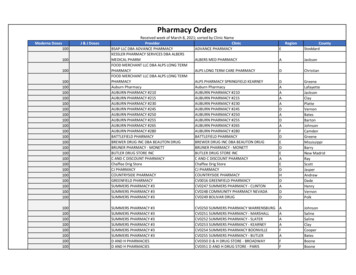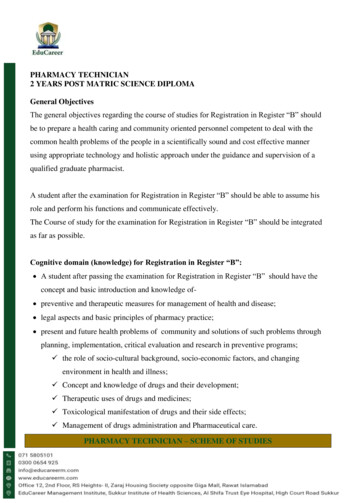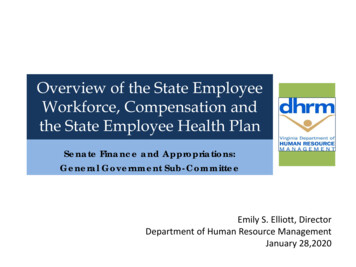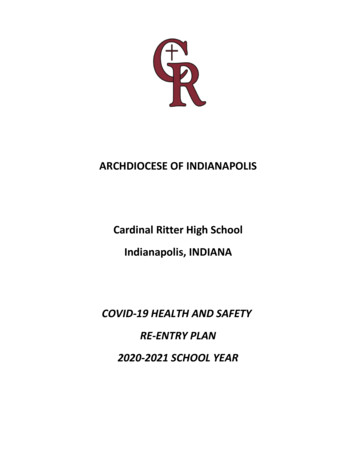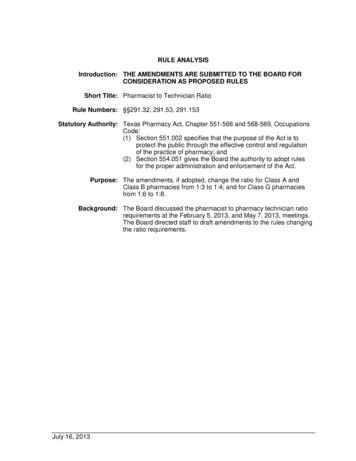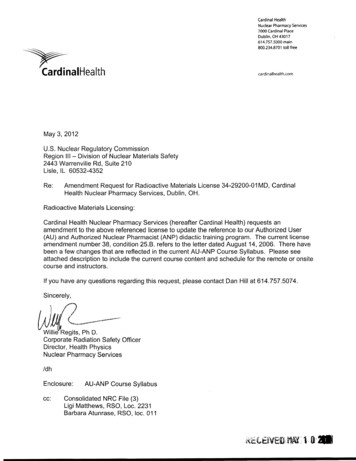
Transcription
Cardinal HealthNuclear Pharmacy Services7000 Cardinal PlaceDublin, OH 43017614.757.5000 main800.234.8701 toll free .CardinalHealthcardinalhealth.comMay 3,2012U.S. Nuclear Regulatory CommissionRegion III - Division of Nuclear Materials Safety2443 Warrenville Rd, Suite 210Lisle,IL 60532-4352Re:Amendment Request for Radioactive Materials License 34-29200-01 MD, CardinalHealth Nuclear Pharmacy Services, Dublin, OH.Radioactive Materials Licensing:Cardinal Health Nuclear Pharmacy Services (hereafter Cardinal Health) requests anamendment to the above referenced license to update the reference to our Authorized User(AU) and Authorized Nuclear Pharmacist (ANP) didactic training program. The current licenseamendment number 38, condition 25.B. refers to the letter dated August 14, 2006. There havebeen a few changes that are reflected in the current AU-ANP Course Syllabus. Please seeattached description to include the current course content and schedule for the remote or onsitecourse and instructors.If you have any questions regarding this request, please contact Dan Hill at 614.757.5074.Sincerely, &-Corporate Radiation Safety OfficerDirector, Health PhysicsNuclear Pharmacy Services/dhEnclosure:cc:AU-ANP Course SyllabusConsolidated NRC File (3)Ligi Matthews, RSO, Loc. 2231Barbara Atunrase, RSO, loc. 011
U.S. NRC - Region IIIRadioactive Materials LicensingMay 3,2012John Alexander, RSO, Loc. 2Amanda Jehl / Dan Burton, RSO, Loc. 10Mathew Svejk, RSO, Loc. 13Christie Holland, RSO, Loc. 16Sharon Jackson, RSO, Loc. 25Asma Abassi, RSO, Loc. 28Earl Robertson, RSO, Loc. 30Jay Simmons, RSO, Loc. 88Byron Alfrey, RSO, Loc. 109Dane Dishman, RSO, Loc. 120John A. Miller, RSO, Loc. 128Mathew Ritchie, RSO, Loc. 172Sarah Pekarek, RSO, Loc. 182Ryan Bonomo, RSO, Loc. 183Mark Peters, RSO, Loc. 200Nate Johnson, RSO, Loc. 201Doug Sopp, RSO, Loc. 3341Mycah Rydman, RSO, Loc. 3306Cliff McClendon, RSO, Loc. 5045NRC License 34-29200-01 MDPage 2
CardinalHealthTHE OHIO STATE UNIVERSITYCollege of PharmacyUniversity Medical CenterAndCARDINAL HEALTHNUCLEAR PHARMACY SERVICESAuthorized User/Authorized Nuclear PharmacistDIDACTIC EDUCATION PROGRAMSyllabusRev 31121
Defining the Role of the Authorized User/Authorized Nuclear PharmacistProperly trained authorized users (AU) (the authorized nuclear pharmacist (ANP) is in aregulation defined class of authorized users who possesses a valid board of pharmacylicense) play the key role in the completion of the many tasks involved with the practiceof nuclear materials manufacturing and nuclear pharmacy. The AU is specially trainedto handle radioactive materials (RAM) in the operation of a nuclear manufacturingfacility or nuclear pharmacy. Additionally, they are required by regulatory agencies forthe handling of RAM. In the PET manufacturing facility, regulatory compliance requiresthat all RAM is handled by or under the supervision of an AU. In the nuclear pharmacy,all handling of radiopharmaceuticals must be handled by or under the supervision of anANP. The AU completes a variety of job functions in the handling of RAM, including thesupervision of non-authorized users, nuclear pharmacy technicians and other handlersof RAM. In order to properly function in the role of an AU, the individual mustdemonstrate working knowledge of the terms, rules, regulations and safe practice ofnuclear manufacturing/pharmacy including the proper techniques in the handling,ordering, storage, preparation, testing, distribution or dispensing, and disposal of RAM.Program DescriptionThe goal of this education program is to provide didactic training for the AU leading to ademonstration of knowledge in radiation physics and instrumentation, math associatedwith radiation, radiation protection including regulatory requirements, and radiationbiology. The AU working in a pharmacy additionally is provided training in proceduresassociated with the calculation and measurement of radiation pharmaceuticals andradiopharmaceutical dosages, and in other areas that would complete administrativeand customer service tasks. The AU will learn the scope of duties and activities inaccordance with applicable rules and regulations. This training should be supplementedwith previous learning experience involving an orientation to the practice of nuclearmaterials. The AU education program provides an opportunity to gain knowledge andunderstanding of the authorized user's work under the supervision of a licensedauthorized user.Regulations require that any person to be named as an AU on a license must undergodidactic training and handling experience commensurate with the level of responsibility.For the Authorized Nuclear Pharmacist (ANP) or Authorized User NPT (AU) the NRCrequires 200 hours of didactic training. For the manufacturing AU, the number of hoursis usually not specified, though 120 hours is seen as adequate. This AU educationprogram is designed to help prepare authorized users for inclusion on a radioactivematerials license. The preceptor is responsible for guiding all authorized user traineesthrough the modules of the distance education portion of the program. The distanceeducation portion is 200 hours of didactic training designed to be completed over a six(6) week period. The onsite portion of the authorized user training is designed tocomplement and complete the distance education portion offered by Cardinal HealthNuclear Pharmacy Services preceptor authorized nuclear pharmacy practitionerslocated around the country.2
The onsite portion of the program is for authorized users in nuclear pharmacies. Duringthe four weeks between the distance learning and onsite portions, students spend a daywith their Cardinal Health sales consultant and spend a day in the nuclear medicinedepartment of a hospital or clinic.The onsite portion is a three (3) week intensive training on radiopharmaceuticals,including their production, uses and dosages. This portion of the program provides anadditional 105 hours for a total of 305 didactic hours for authorized users in nuclearpharmacies.This program, whether just the distance learning (for those working in nuclearmanufacturing facilities) or the full nuclear pharmacy AU preparation, will not make aperson an AU (ANP). This merely fulfills the regulatory requirements for didactic trainingset forth by the various regulatory agencies. Additional experience with the handling ofRAM also is required. For the nuclear pharmacy AU candidate, this is a minimum of 500hours of experience handling RAM of the type and activity associated with the normalpractice of nuclear pharmacy (under the supervision of a preceptor if an ANPcandidate). For the nuclear manufacturing candidate, this is minimum 120 hours. Eachmust be under the supervision of an already named AU (ANP). Even so, this onlyqualifies the person as an AU (ANP) in the eyes of a regulatory agency. The true AUconstantly strives to improve technique in the handling of RAM so as to maintainexposure to radiation ALARA (As Low As Reasonably Achievable).Prog ram ObjectivesThe six-week distance education training consisting of both didactic and laboratoryexperience will assure mastery of the self-study material and provide hands-onexperience with the primary components of the job function of the authorized user.1. Demonstration of appropriate knowledge and understanding of the principlesinvolved with radiation physics, radioactive decay, and the math pertaining toradiation physics and radioactive decay, including statistics used in counting ofradioactive decay.2. Demonstration of appropriate knowledge and understanding of the principles in theshielding of radioactivity, dosimetry, and other principles of radiation protection.3. Demonstration of appropriate knowledge and understanding of the principlesinvolved with the instrumentation associated with the measurement of radiationand radiation fields.4. Demonstration of appropriate knowledge and understanding of radiation biologyand the effects of radiation on living tissue, especially in humans.5. Demonstration of appropriate knowledge and understanding of the variousregulations that relate to possession and transportation of radioactive materials.6. Demonstration of appropriate knowledge and understanding of the policies andprocedures of the appropriate Cardinal Health Radiation Safety Manual (NuclearPharmacy Services or PET Manufacturing Services) and how these policies relateto compliance with regulatory requirements.3
7. (AU for a nuclear pharmacy only) Demonstration of appropriate knowledge andunderstanding of the chemistry of byproduct material for medical use, includingimaging techniques and current radiopharmaceutical technology.8. (AU for nuclear manufacturing facility only) Demonstration of appropriateknowledge and understanding of the principles of radiation physics and radiationdetection instrumentation that is unique to a nuclear manufacturing facility,including neutron physics.The three-week onsite training consisting of both didactic and laboratory experience willassure mastery of the self-study material and provide hands-on experience with theprimary components of the job function of the authorized user.1.2.3.4.5.6.7.To demonstrate knowledge of the current practice of nuclear medicine andnuclear pharmacyTo describe the use and operation of radionuclide generatorsTo explain technetium, indium, and iodide chemistryTo evaluate clinical application of radiopharmaceuticalsTo explain the mechanism of localization, biodistribution, and radiation dosimetryof technetium, iodide, and indium radiopharmaceuticalsTo perform mathematical calculations involved in nuclear pharmacyTo interpret the regulations involving radiopharmaceutical preparation anddistributionBased on these objectives, experiential training and demonstration of competencies willinclude a total of either six (6) weeks of training and evaluation for nuclearmanufacturing, or nine (9) weeks of training and evaluation for nuclear pharmacies.4
InstructorsAmy SchneesHealth PhysicistNuclear Pharmacy ServicesCardinal Health614-757 -4592E-mail amy.schnees@cardinalhealth.comRichard Green, R.Ph., BCNPDirector Radiopharmacy PracticeNuclear Pharmacy ServicesCardinal Health614-757-3174E-mail richard.green@cardinalhealth.comGeorge H. Hinkle, M.S., R.Ph., BCNP, FASHP, FAPhAAssociate Professor, College of PharmacyThe Ohio State UniversityDirector of Nuclear Pharmacy Services, Department of PharmacyThe Ohio State University Medical CenterRoom 2030, Doan Hall410 West Tenth AvenueColumbus,OH 43210Phone: 614-293-8751FAX: 614-293-2529E-mail hinkle.5@osu.eduPaul Knapp, R.Ph., MBA, BCNPProgram ManSlger Clinical SupportNuclear Pharmacy ServicesCardinal Health614-757-6713E-mail paul.knapp@cardinalhealth.comJanet Robertson, R.Ph., BCNPProgram Manager Pharmacy PracticeNuclear Pharmacy ServicesCardinal Health614-652-1870E-mail janet.robertson01@cardinalhealth.com5
------------- ---------Willie Regits, Ph.D.Director Health PhysicsNuclear Pharmacy ServicesCardinal Health614-757-3147E-mail willie.regits@cardinalhealth.comDan HillHealth PhysicistNuclear Pharmacy ServicesCardinal Health614-757 -507 4E-mail dan.hiIl01@cardinalhealth.comVaiPayeSenior Health PhysicistNuclear Pharmacy ServicesCardinal Health614-757-2646E-mail vai.paye@cardinalhealth.comEvan WesternHealth PhysicistNuclear Pharmacy ServicesCardinal Health614-553-4555Email: evan.western@cardinalhealth.comRandy KuhnerHealth and Safety SpecialistNuclear Pharmacy ServicesCardinal Health614-757-5651E-mail randy.kuhner@cardinalhealth.com6
The Distance Learning PortionIn an effort to both strengthen your candidate, and to give you an opportunity to gaugetheir ability to perform in a nuclear pharmacy or nuclear manufacturing environment, afour-week pre-training period has been added prior to the initiation of the current sixweek distance-based authorized user didactic program. This four-week period is meantto expose the candidate to as many shifts and facility duties as possible, in order foreveryone involved to be aware of the expectations and potential performance issuesspecific to each employment situation prior to the individual's probationary periodending.The four-week period is meant to give the local team the chance to have the candidateshadow the preceptor or another designated authorized user through as many shiftsand duties as possible. Ideally, the candidate will complete all required training anddocumentation and then be able to work one week of opening shifts, one week of mid day shifts and one week of closing shifts. In addition, the candidate should be givensome experience with on-call duties as well as weekend shifts. Of course, the specificsof each locations operations will dictate different experiences, but the goal is to have thecandidate experience as much of the location's normal workload as possible. If nosignificant difficulties are experienced, the candidate can then begin the six weekdistance-based authorized user program.It has been decided that the four-week pre-training period will not be made a mandatorypart of the authorized user training program, but it is highly recommended. To stressthis point, any deviations from the four-week period will require the approval of theapplicable Vice President of Operations or PET, the notification of Q&R and thedevelopment of a candidate specific plan to ensure both their successful completion ofthe didactic training and that there will be an opportunity for the local team to expose thecandidate to the full nuclear pharmacy/nuclear manufacturing experience prior to theDublin-based portion of the authorized user program.The distance learning portion of the class is a computer based set of Adobe Acrobatdocuments, homework exercises, and laboratory experiments. All are providedelectronically to the students. Although they are in a self study format, there is aminimum progression of modules that should be performed in order to successfully passthe exams (see the schedule). The schedule is an example only. Some students mayproceed at a faster pace, and it is possible holidays may occur during the schedule.These specifics will be discussed at the first conference call (during week 0). Thepreceptor must allow the student time to complete this work.Computer hours are now listed as required weekly hours and are the average time astudent would probably need to complete weekly modules. This is the minimum amount7
of computer time the preceptor must give the student for completion of that week'smodules. This time can be scheduled at the discretion of the preceptor, but must beduring the student's regular shift. Homework, laboratory work and study time are notincluded. Time for study and homework are managed by the preceptor. This may bedone in the facility during normal working hours, at the discretion of the preceptor. It isunderstood that some study and/or homework may need to be done after the student'sregular shift. However, it is up to the student and preceptor working together todetermine when during the week these modules are to be completed. All othertime is mentored by the preceptor, and it is up to the preceptor to determinewhether the student needs extra time for study and homework.Three lists of suggested tasks (one for each exam) to be completed prior to the end ofeach week is included on the class CD. The goal is to allow students to realize wherethe information being learned is useful in their daily pharmacy activities. Preceptorsshould meet with students periodically to review and check off each task once thestudent has performed them.The exams typically include multiple choice type questions (usually worth 2 points each)and other questions that include calculations or require exposition (usually worth 5points each). A minimum score of 70 is required to pass an exam. A candidate isallowed one (1) make up exam. All three exams must be passed in order for acandidate to successfully pass the distance learning portion. Exams are closed noteand closed book except for a single sheet that contains commonly used formulas (thissheet is supplied), and are proctored by the preceptor. In order to ensure security of theexams, they will be either be emailed to the proctor 15 minutes prior to the start of theexam or administered throUgh a learning management system electronically. Studentshave a four hour timeframe to complete the exam. The learning management systemwill lock the student out of the exam after the four hour mark. Students faxing theirexamstoQ&RmustsendexamselectronicallytoGMB AURemoteExam@cardinalhealth.com or fax it to 614.553.9165 before the four hourmark, otherwise the exam will be voided and will count as a fail. Homework andlaboratory experiments are not collected or graded, but will be discussed at theconference calls, and exam questions frequently reflect homework and experimentalresults. Exams typically occur every other week.Preparation for Onsite PortionDuring the approximately four weeks between the distance and onsite portions, thosetraining to become authorized users in a nuclear pharmacy will spend a day in a nuclearmedicine department at a hospital or clinic, and spend a day with their Cardinal Healthsales consultant.The purpose of the hospital or clinic visit is to introduce students to the daily practice ofnuclear medicine, to increase awareness and appreciation of the needs of a nuclearmedicine department, and to enhance communication with the nuclear medicineprofessional.8
Time also will be spent with students' pharmacy field sales consultants to learn the roleof sales. This assignment educates the new AU in the duties, responsibilities andresources of Cardinal Health sales consultants. It also enhances communication andincreases appreciation of the interactions between the sales consultants, the pharmacy,and the customer.Onsite Class PortionThe onsite portion of the didactic training is designed for the AU in the nuclearpharmacy. This is three (3) weeks of intensive training on radiopharmaceuticals,including their production, uses and dosages. Students attend class daily from 8 a.m. to5 p.m., Monday through Friday. Additional time outside of class will be necessary inorder to complete homework assignments and prepare for exams. The course formatconsists of lectures utilizing handouts, audiovisuals, demonstrations, and discussionsincluding problem-solving sessions, supervised laboratory practice and homeworkassignments. In order to receive credit, students must attend all class sessions andscore a minimum of 70% on each of the following four scored activities: 3 clinical examsand the homework assignments/clinical case presentation component. In addition, twolaboratory practical exams must be completed on a pass/fail basis. Only one clinicalexam retake, and one laboratory practical exam retake, are permitted during theduration of the onsite course.Authorized Nuclear Pharmacist candidates (and NPT AU candidates if needed) willreceive 50 contact hours (5 CEUs) of pharmacy continuing education after successfulcompletion of the onsite portion. Statement of credit will be issued on the day ofcompletion of the program. The Nuclear Pharmacy Services business of CardinalHealth is accredited by the Accreditation Council for Pharmacy Education (ACPE) as aprovider of continuing pharmacy education.9
Description of Modules for Distance Learning PortionThe hours listed for the distance courses reflect the average minimum time necessaryfor completion of the module, and does not include study time or homework time. Moststudents will take longer for completion. Hours are minimum needed per week forcompletion of the required modules for that week. The letters following each modulerefer to the category of training as outlined by the NRC (see last page).Distance learning Week 0:Introductory Conference Call: BIntroduction to the distance learning portion of the class; description and reasons forprogram; logistics of program; requirements for passing.Distance learning Week 1: Minimum hours 15 hoursMath, Physics and Chemistry Review: CReview of basic concepts from mathematics, including scientific notation, units and unitconversions, exponents and logarithms, significant figures, and solving equations, asthey relate to radioactive materials and radiation in general; basic concepts in physics,including force, work and energy, and charge; concepts from chemistry, includingatomic structure and the structure of matter itself.Radioactivity: ABasic concepts of radiation and radioactivity; types and mechanisms of radioactivedecay; decay products and decay series; examples of common radionuclides.Half-Life and Decay: CRadioactive decay and half-life; why some elements undergo radioactive decay and theunits used to measure it; half-life and the decay constant in the radioactive decay law.Experiments with half-life and radioactive decay.Statistics: CRadiation counting and probability statistics. Experiments with counting.Basic Cyclotron Theory and FDG Synthesis Overview: ASpecific to the cyclotron students, basic cyclotron and FOG synthesis overviewConference Call: BConference call to go over the week's modules, homework and laboratory work.Distance learning Week 2: Minimum 15 hoursNuclear Interactions: AInteractions of radiation, both charged particles, and uncharged radiation, with matter;charged particle interactions, including ionization and excitation; uncharged interactions,10
including the photoelectric effect, pair production and Compton scattering; stoppingpower, linear energy transfer and attenuation coefficients.Shielding: AAttenuation, HVL, TVL and buildup. Experiments with shielding.Dosimetry: BReview of dosimetry, the measurement of ionizing radiation doses, and the differentdosimetric quantities involved in monitoring radiation exposure; differences betweenexposure, absorbed dose, and dose equivalent for external exposure; internal exposureand monitoring intake of radiation; Annual Limit on Intake (ALI), Derived AirConcentrations (DAC) and Effluent Limits.Safe Handling: BSafe use of radioactive material; ALARA concept and the principles behind it; how tominimize external and internal exposure by applying the ALARA principle. Experimentswith safe handling.Neutron Physics: ASpecific to the cyclotron students, Neutron physics and shielding conceptsConference Call: BConference call to go over the week's modules, homework and laboratory work.Distance learning Week 3: Minimum 15 hoursInstrumentation: ADifferent methods of detecting radiation.Gas Filled Detectors & Resolving Time: AGas-filled radiation detectors, including Geiger-Mueller (GM) detectors and ionchambers.Scintillation Detectors: AScintillation detectors, such as the bioassay probe and the detectors for the single channel and multi-channel analyzers.Efficiency, LLD, MDA, Resolving Time: A, CEfficiency, lower limit of detection, and minimum detectable activity of a radiationdetector. Experiments with efficiency, LLD and MDA.MeA, E Resolution, & ROI: AMulti-channel analyzers; concepts of efficiency, lower limit of detection, and minimumdetectable activity of a radiation detector in more depth. Experiments with MCA.PET Safe Handling: B11
Specific to the cyclotron students, safe handling of radioactive material in amanufacturing site and common tasks that may incur exposure, ways to reduceexposureConference Call: BConference call to go over the week's modules, homework and laboratory work.Distance learning Week 4: Minimum 15 hoursHoods & Air Sampling: AFume hoods, glove boxes, and air monitoring in the nuclear pharmacy. Experimentswith hoods & air sampling.PET Hoods & Air Monitoring: ASpecific to the cyclotron students, fume hoods, hot and mini cells, air monitoring, peakstripping.Survey Meters: ASurvey meters used throughout Cardinal Health. Experiments with survey meters.SCA & Bioassay: ASingle channel analyzer (SCA) and the bioassay procedure. A more detailed bioassayprocedure is made during the second half of ANP training. Experiments with SCA andbioassay.Emergency Procedures: BPotential emergencies that can happen at a Cardinal Health facility and the responsesto those emergencies. Experiments with emergencies.Conference Call: BConference call to go over the week's modules, homework and laboratory work.Distance learning Week 5: Minimum 15 hoursRadiation Biology: ESourcesSources of radiation, how they vary geographically, and where most radiationexposure comes from.Historical BackgroundDiscovery of radiation and the history of radiation protection.Exposure DefsDefinitions used in radiation biology; LET, range, RBE; acute and chronic dose; dosefractionation; cell survival curves.Cell Structure and FunctionHuman cell structure and functions of various components of a cell; processes bywhich a cell is produced and replicated.12
Radiation Damage in Living TissueHow radiation affects human tissue on the cellular and genetic levels.Effects of Radiation (Defs)Definitions of the effects of radiation on human tissue.Genetic EffectsGenetic effects of radiation, why they occur, and some examples of genetic effects.Non-stochastic EffectsNon-stochastic effects, such as acute radiation syndrome types, effects on variousorgans, and treatment; several case studies including Goiania, Brazil and Chernobyl.Stochastic EffectsSomatic and stochastic effects in detail.Study GroupsStudy groups which have provided information regarding the effects of radiation onliving tissue; studies ranging from laboratory animals to survivors of actual radiationevents such as the Chernobyl incident.Conference Call: BConference call to go over the week's modules, homework and laboratory work.Distance learning Week 6: Minimum 15 hoursRadiation Biology: ELow Dose StudiesDifferent low dose studies; results and conclusions of these studies, and theiradvantages and disadvantages.In Utero EffectsIn utero effects of ionizing radiation.Risk AssessmentRisk models, including Linear No Threshold (LNT), Linear Threshold, and LinearQuadratic; genetic and cancer risk assessments; perspective of risks.DOT Regulations: BRegulations of the DOT and how they apply to Cardinal Health facilities.Radioactive Materials Regulations: BNuclear Regulatory Commission (NRC) rules that govern the use of radioactivematerial.Using the Cardinal Health Radiation Safety Manual: BConference Call: BConference call to go over the week's modules, homework and laboratory work.13
Description of Modules for Onsite PortionThe hours listed for the onsite courses reflect the minimum time necessary forcompletion of the topic, and do not reflect homework or study time.Instrumentation Review (HP): A, C -10 hoursReview and hands on experience using survey meters, SCA, MCA, performing bioassayand routine surveys.Human Resources Presentation: B-1 hourSupervisory and other HR aspects of managing a radiation safety program. Rules,regulations and boundaries when safety is involved in people management.Health and Safety Program Overview: B-2 hoursOverview of requirements under OSHA's health and safety regulations; topics includeBloodborne Pathogen Standard and its requirements, occupational exposure tobloodborne pathogens and exposure reduction techniques; review of chemical hazardsand the Hazard Communication Standard with an emphasis on hierarchies of exposurecontrol; generation of medical waste in the nuclear pharmacy and an understanding ofmedical waste regulations; review of the Cardinal Health NPS distance learningcomputer based training that includes training modules for all major required trainingsubjects: radiation safety, general health and safety and blood borne pathogens, andDOT training; review of major emergency scenarios and action plans; understanding theDriver's Safety Program and its requirements. Students will participate in Health andSafety program scenarios in order to emphasize required programmatic elements forhealth and safety in the nuclear pharmacy.Incident Response (HP): B-2 hoursPractice at responding to emergencies involving radioactive materials and properprocedures to follow.USP 797 Changing the Face of Nuclear Pharmacy: B-1 hourDefining who USP is; outlining the contents of chapter 797 2004; bridging the gapbetween the inherent conflicts between radiation safety requirements in the practice ofNuclear Pharmacy and the literal read of USP 797 ; introduction of augmented andnew SOPs to be implemented towards achieving compliance with 2004 797 reg ulations;Pharmaceutical Event Reporting: B-1 hourDefining required prescribed pharmaceutical events; highlights of "best practice"recommendations to avoid events; reviewing and recommending appropriate reportingguidelines.Production of Radioisotopes: A - 4 hoursDiscussion of how short lived radioactive materials for medical use are produced,including accelerator production, nuclear reactors and radionuclide generator systems;14
concepts of radionuclidic contaminants, licensing, available manufacturers and logistics;extensive discussion of Mo-99 generators including kinetics, carrier, expected yield anddisposal.Gamma Cameras and Sealed Sources: A - 1 hourReview of general operational characteristics of a scintilization gamma camera and howthe ANP can assist the NMT in maintaining its correct function; scintilization event,detector crystals and efficiencies, PM tubes, collimators, quality control testing, floodfields, resolution and sensitivity, bar phantoms; introduction to sealed sourcesencountered in Nuclear Medicine & Radiopharmacy including their uses and licensing.Radiopharmaceutical Chemistry: D - 4 yinvolved lableisotopeforms,radiopharmaceutical labeling reactions, bifunctional chelates, chemical stability.Quality Control: C, D - 4 hoursQuality control and quality assurance testing methods for manufacturer provided andcustom compounded radiopharmaceuticals; thin layer chr
For the nuclear pharmacy AU candidate, this is a minimum of 500 . manufacturing, or nine (9) weeks of training and evaluation for nuclear pharmacies. 4 . Instructors Amy Schnees . Health Physicist . Nuclear Pharmacy Services . Cardinal Health . 614-757 -4592 . E-mail amy.schnees@cardinalhealth.com .
